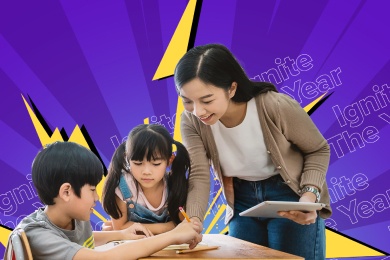Planning Less, Teaching Better: How to Keep it Light and Focused
Did you know that teachers, on average, spend about two extra hours per day planning lessons?
And that’s outside of their regular work hours, and an average (with many teachers spending significantly more time than that on lesson planning). That doesn’t say anything about grading assessments, sending emails, attending meetings, and so on.
It’s no surprise, then, that the start of the school year can feel like you’re gearing up for a marathon as you juggle lesson plans, classroom management, parent communications, and everything in between.
But here’s the thing: more planning doesn’t always translate to better results. If you want your students to succeed, you’ve got to work smarter, not harder. You need to keep it light, focused, and intentional.
So how exactly do you do that? In this post, we acknowledge your hustle—but we also want to take some of the work off your plate with our practical tips on how to spend less time planning (and more time thriving) as an educator.

The “More is Better” Trap
It’s easy to fall into the trap of believing that the more elaborate and detailed your lesson plans (thanks, Pinterest), then the more impactful your teaching will be.
However, the truth you need to know is this: students don’t thrive because of perfectly color-coded binders or overly detailed plans. They thrive because of you, your energy, and your ability to connect and adapt.
If you’re overworked, you can’t be any of those things. You’ll be exhausted, running on empty before the first bell even rings. By streamlining your planning process, you can free up more time and energy for what really makes a difference in the classroom: your presence, creativity, and passion for teaching.
The alternative? Keep your plans light and focused. By doing so, you accomplish the following:
- Make room for flexibility: Students are unpredictable, and the best learning often happens organically.
- Encourage authentic engagement: Simple plans leave space for those golden "aha!" moments.
- Protect your well-being: Fewer hours planning means more time for yourself, your family, and your sanity.
Remember, teaching isn’t about perfection. It’s about connection. And if you want to connect with your students in the most authentic ways possible, it’s time to put down the planner. Less really is more.
3 Biggest Misconceptions About Simplifying Lesson Planning
It’s easy to assume that every “i” needs to be dotted and every “t” needs to be crossed as you think about how you’ll teach this upcoming school year.
But that’s not necessarily the case. Here are a few common misconceptions:
- If I Don’t Plan Every Detail, My Lessons Will Fall Apart
Not true. Some of the best lessons come from going with the flow and adapting to the needs of your students in real time. Planning just enough creates a scaffold for structure, but leaves space for exploration. - I'm Not Working Hard Enough if I’m Not Buried in Lesson Plans
False again. Working smarter, not harder, is key to longevity in teaching. Effort that improves outcomes is valuable; busywork that drains your energy isn’t. - My Students Will Notice if I Simplify My Plans
Actually, they’ll notice when you’re less stressed and more focused on them. Your energy and enthusiasm matter exponentially more than elaborate worksheets.

How to Streamline and Simplify Your Planning Process
With those misconceptions in mind, here’s how you can let go of the reins and keep your planning light, focused, and impactful:
- Identify Your Core Learning Objectives
Start every planning session by asking yourself, “What’s the ONE thing my students really need to walk away with today?” Write it down and build your plan around it. - Use Proven Frameworks, Not Reinvented Wheels
Tap into frameworks like Backward Design (start with the end in mind) or The 5E Model (Engage, Explore, Explain, Elaborate, Evaluate). These help you build effective lessons without overcomplicating the process. - Rethink Teaching Resources
Leverage pre-made resources designed to make planning easier! Websites like Teachers Pay Teachers and Pinterest provide quality, ready-to-use materials. - Batch Your Planning
Set aside blocks of time to plan multiple lessons at once. Choose, say, a Sunday afternoon to focus, instead of doing piecemeal planning every night. - Collaborate with Fellow Educators
Your biggest support system is your peers. Share resources, swap ideas, or co-plan with department members. - Leave Room for Flexibility
Always build "buffer moments" into your plan—for discussions, questions, or moments of unexpected engagement.
Beyond the Plans, Focus on the Spark
Simpler, focused planning isn’t just about saving time. It’s about maintaining the joy that you bring into the classroom.
Your students aren’t looking for perfection. They’re looking for connection, inspiration, and a guide who shows up with their full self—not someone still writing plans at 2 a.m. the night before.
Our advice is this: Lighten the load. Focus on the essentials. You’ll be amazed by how much teaching energy and excitement comes back into your life.
If you’re looking for tools to keep the spark going all year long, we have a range of resources designed to save you time, energize your classroom, and inspire fresh ideas.
You’ve got this. Your best teaching moments are waiting. And they don’t require an overstuffed planner to happen.
Keep the Spark Going
There’s something quietly powerful about the start of the new academic year. Beyond the fresh supplies and clean whiteboards, it’s a chance to begin again—with your students, your team, and yourself. Those early days carry the weight of possibility, and how you begin can shape everything that follows.
Igniting the year doesn’t mean having to do it all. It means choosing what brings meaning, what builds connections, and what helps you feel proud at the end of the day. Even the smallest changes can light the way forward.








